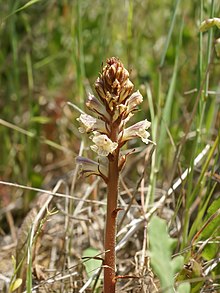Orobanche crenata is a species of broomrape, commonly known as bean broomrape.[2] It is a common parasite of the faba bean, Vicia faba.[3] It is native to the Mediterranean basin in Europe and North Africa, the Arabian Peninsula, and Western Asia through to Iran. It has been introduced elsewhere, including Ethiopia.[1] It has no chlorophyll, and gets its carbohydrates from the host's phloem, and water and minerals from the host's xylem. It is a constant threat to legume production.[4] However, Orobanche crenata has been found to be very beneficial to humans, when consumed O. crenata provides nutrients, anti-tumors, antimicrobial compounds and antioxidants.[citation needed]
| Orobanche crenata | |
|---|---|

| |
| Scientific classification | |
| Kingdom: | Plantae |
| Clade: | Tracheophytes |
| Clade: | Angiosperms |
| Clade: | Eudicots |
| Clade: | Asterids |
| Order: | Lamiales |
| Family: | Orobanchaceae |
| Genus: | Orobanche |
| Species: | O. crenata
|
| Binomial name | |
| Orobanche crenata Forssk.[1]
| |
References edit
- ^ a b "Orobanche crenata Forssk". Plants of the World Online. Royal Botanic Gardens, Kew. Retrieved 2020-09-28.
- ^ "Orobanche crenata Forsk". Retrieved September 12, 2012.
- ^ Maalouf, Fouad; Khalil, Shaaban; Ahmed, Seid; Akintunde, Akinnola N.; Kharrat, Mohammed; El Shama’a, Khaled; Hajjar, Samir; Malhotra, Rajinder S. (2011-12-20). "Yield stability of faba bean lines under diverse broomrape prone production environments". Field Crops Research. 124 (3): 288–294. doi:10.1016/j.fcr.2011.06.005.
- ^ Genovese, Carlo; D’Angeli, Floriana; Attanasio, Francesco; Caserta, Gaetano; Scarpaci, Kevin Sebastiano; Nicolosi, Daria (2020-03-12). "Phytochemical composition and biological activities of Orobanche crenata Forssk.: a review". Natural Product Research. 35 (22): 4579–4595. doi:10.1080/14786419.2020.1739042.